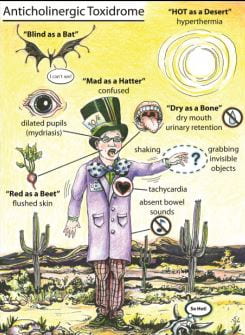 Image from: Accessed 15 July 2019
Image from: Accessed 15 July 2019
Nightshade is a group of flowering plants otherwise known as “Solanaceae”, consisting of almost 3,000 different types, most of which are harmless and even part of every day consumption such as tomatoes, eggplant, and bell peppers. However, the one that usually comes to mind due to its poisonous qualities is “Belladonna” or Deadly Nightshade, a light purple flower with dark purple berries (seen below).
 Image from: Accessed 15 July 2019
Image from: Accessed 15 July 2019
Biotransformation
Nightshade plants contain steroidal alkaloids, which can be toxic when ingested however the biosynthesis is largely unknown. It is suggested that “specialized metabolites serve as a chemical barrier” and “affect the digestion and absorption of nutrients from food” according to an article published in 2015 by Cardenas, et al. Simulated tests for the ingestion of atropa belladonna suggest that the compound 3,4,5-trimethoxybenzaldehyde goes through toxic oxidation processes in the body, causing its deadly capabilities. For an in-depth scientific review of this hypothesis, read the article published in 2012 by Srivastava, et al. here.
Toxicokinetics and Mechanism of Action
Image from: Accessed 15 July 2019
 GIF from: Accessed 15 July 2019
GIF from: Accessed 15 July 2019
When ingested, atropa belladonna is one of the most toxic plants in the world due to the high concentration of tropane alkaloids within the plant. Below is a list of information about tropane alkaloids.
- Used in some pharmaceuticals for anticholinergic properties (for instance, Parkinson’s medication)
- Can worsen certain conditions such as congestive heart failure and diabetes mellitus
- Belladonna contains three major tropane alkaloids:
- Atropine – works by blocking acetylcholine at muscarinic receptors, often used as an antidote in nerve agent and pesticide poisonings: side effects include tachycardia, hallucinations, dizziness (1)
- Scopolamine – works as a competitive inhibitor for receptors in the parasympathetic nervous system, often used to aid in stopping nausea and vomiting: side effects include confusion, agitation, urinary retention (2)
- Hyoscyamine – works as an antagonist of muscarinic receptors, often used for GI disorders such as Irritable Bowel Syndrome: side effects include irregular heart beat, dry mouth, headache (3)
 Image from: Accessed 21 July 2019
Image from: Accessed 21 July 2019
Information derived from:
(1) RxList. 2019. “Atropen”. <https://www.rxlist.com/atropen-drug.htm#description> Accessed 15 July 2019.
(2) RxList. 2019. “Scopolamine”. <https://www.rxlist.com/consumer_scopolamine/drugs-condition.htm> Accessed 15 July 2019.
(3) American Society of Health-system Pharmacists. 2019. “Hyoscyamine”. <https://medlineplus.gov/druginfo/meds/a684010.html> Accessed 15 July 2019
Target Organs and Signs/Symptoms of Toxicity
 Image from: Accessed 15 July 2019
Image from: Accessed 15 July 2019
The above image is a set of mnemonic devices to remember Anticholinergic toxicity.
The main target of atropa belladonna is the central nervous system – mainly the postganglionic muscarinic receptors. Impact also includes smooth muscles due to their response in activation to acetylcholine.
TREATMENT
- Activated charcoal
- Gastric lavage
- Hemodynamic monitoring
- Ventilation for respiratory support
- Benzodiazepines (for treatment of agitation)
- Physostigmine (cholinesterase inhibitor that can cross the blood-brain barrier to help with central and peripheral nervous system activity)
Two interesting cases in which you can read about the above various treatments can be found in these articles:
Berdai, Labib, Chetouani, & Harandou. “Atropa belladonna intoxication: a case report”. The Pan Aferican Medical Journal. 2012: 11(72). <https://www.ncbi.nlm.nih.gov/pmc/articles/PMC3361210/>
Demirhan, et al. “Anticholinergic toxic syndrome caused by atropa belladonna fruit (deadly nightshade): a case report”. Turkish Journal of Anaesthesiology and Reanimation. 2013: 41(6). <https://www.ncbi.nlm.nih.gov/pmc/articles/PMC4894214/>
Unique News
In 2010 and again in 2017 the Food and Drug Administration reported a case where a homeopathic teething treatment for infants was found to contain dangerous amounts of Atropa belladonna, which could result in infant death. For information regarding the recalled product please see the below links:
Hyland’s Homeopathic Teething Tablets: Questions and Answers
Hyland’s Homeopathic Teething Tablets Recalled Nationwide
Image from: Accessed 15 July 2019
No conclusive biomarkers for nightshade toxicity exist.
 Cartoon from: Accessed 15 July 2019
Cartoon from: Accessed 15 July 2019